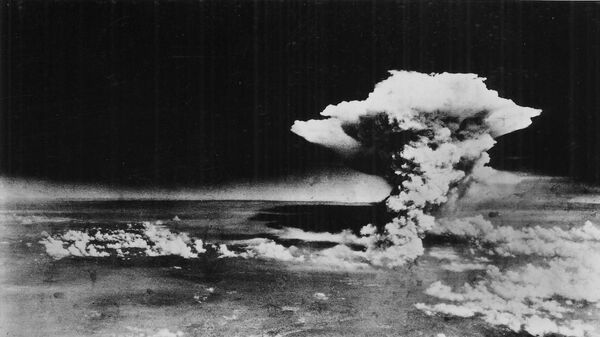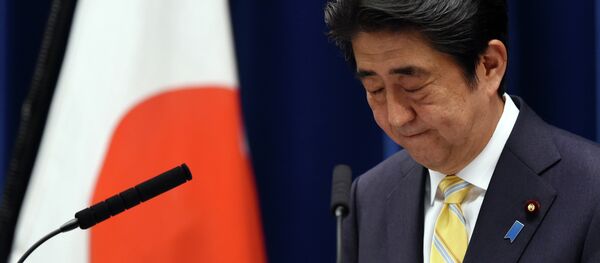On August 6, 1945, Lt. Col. Paul W. Tibbets’ B-29 Enola Gay bomber took off to the targeted areas preceded by three weather reconnaissance planes. At a distance of some 7 miles it was followed by a plane with nuclear measurement instrumentation. A bomber with photographic equipment flew some 43 miles away.
One hour before the bombing, Japan’s early warning radars detected the approaching of several aircraft, but the air alarm sounded in Hiroshima was shortly followed by an all-clear signal as there were shown to be so few aircraft that the approach was not considered a serious threat.
After visual targeting, the Little Boy bomb, with a uranium charge equivalent to about 15,000 tons of TNT was dropped over the city at 8:15 a.m. local time. It exploded at an altitude of about 0.37 miles above ground.
The blast instantly killed about 80,000 people and wounded 40,000. Over 12,000 were never accounted for. Fires continued in a radius of four km from the epicenter for many hours. All buildings were destroyed in an area of over 4.6 square miles; of 90,000 buildings 62,000 were razed.
At 11:01 a.m. on August 9, US pilots dropped the Fat Man, a second nuclear bomb, on Nagasaki. It had a plutonium charge equivalent to about 20,000 tons of TNT. The irregular terrain and a 1.2 mile deviation from the target (the center of the city) slightly reduced human loss and destruction. Over 73,000 people were killed or missing.
Another 35,000 died from radiation and wounds over time. Over half of the victims had burns, and up to 30 percent were injured by the shock wave. About 20 percent were affected by nuclear radiation. Fires destroyed the bulk of the buildings not flattened by the blast.
The two blasts accounted for about 300,000 victims (dead or missing), while approximately 200,000 people suffered from radiation burns or poisoning.
The nuclear bombings of Hiroshima and Nagasaki are, and hopefully will remain, the only examples of combat use of nuclear weapons in human history.
Through these bombings, the United States primarily pursued the political goals of demonstrating its power using nuclear weapons to intimidate other nations and ensure its own strategic superiority.
The first World Conference Against Atomic and Hydrogen Bombs met in Hiroshima on August 6, 1955. In 1985, the Treaty of Rarotonga declared the South Pacific a nuclear free zone.
Hiroshima symbolizes the mass destruction weapons ban cause. The whole world marks Hiroshima Day, and memorial ceremonies are held in the city on August 6. An empty space with ruins is left in the city center forever as reminder of the appalling tragedy.
Every year, peace marches against war and nuclear weapons are organized in Japan. Participants cover over 6,200 miles along 13 routes in all 47 prefectures and finish their march on August 6 at Hiroshima’s Peace Memorial Park, which surrounds the blast epicenter.
The Memorial Cenotaph, under its concrete canopy, holds the names of the blast victims under a limestone slab. The names of recently deceased survivors are added to the list every year. The slab is inscribed: “Let all the souls here rest in peace for we shall not repeat the evil.”
The Peace Memorial Museum is nearby. The museum has the Peace Bell. All passersby are encouraged to ring it and remind people of the threat of an nuclear war.
The ceremony ritual of the Hiroshima Day includes a minute of silence, a flock of doves and a tolling of the bell. Afterwards, lists of people who died as a result of the consequences of the nuclear bombing over the past year are entered into the memorial.
The 2010 Memorial Ceremony was the first to be attended by a US representative, John Roos, a US Ambassador to Japan. UN Secretary General Ban Ki-moon also participated in the ceremony.
In 2012, the ceremony was attended by Clifton Truman Daniel, senior grandson of former US President Harry Truman.
In 2014, the Hiroshima Day events were attended by Japanese Prime Minister Shinzo Abe, government members, lawmakers and delegates from 68 countries.
In Russia, many events relating to Hiroshima Day are held in Volgograd (formerly Stalingrad). In 1972, Hiroshima and Volgograd, united by a common pain, heavy losses and near-complete destruction during WWII, became sister cities in 1972. In 1985, the Hiroshima authorities presented Volgograd with a bell that is now at the Battle for Stalingrad Panorama-Museum. The symbolic tolling of this bell at 8:15 a.m. on August 6 signals the start of the commemorative ceremony for the victims of the Hiroshima tragedy.







